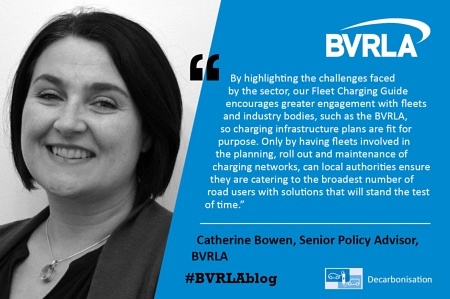Catherine Bowen, Senior Policy Advisor at the BVRLA highlights the association's new Fleet Charging Guide, aimed at helping to inform local authorities but requiring engagement with fleets and industry bodies for solutions that will stand the test of time.

The recent announcement that the Plug-in Van Grant has been confirmed for another two years – taking us to 2024/25 – is a welcome one and shows that policymakers acknowledge the different approaches needed for cars and vans. While that will support the transition to zero-emission motoring from a vehicle supply perspective, significant barriers remain when looking at infrastructure.
We need a seismic acceleration in the delivery of charging solutions, taking us from the current situation of around 29,000 charge points into a fully supported infrastructure that can power the 11 million EVs expected on the road by 2030[1]. Solutions need to be developed and implemented across the board, requiring extensive cooperation between those in the private sector as well as policymakers, energy companies, regional business representatives and automotive manufacturers themselves.
Fleets have always led the drive to decarbonisation and will continue to do so, yet charging strategies have been focussed on individual drivers and private use cases. This approach needs to change for the network to deliver in the way it is required to.
The BVRLA recently developed and launched its Fleet Charging Guide, compiling the findings of extensive research conducted with a variety of fleet operators, including those with car clubs and rental divisions. The Guide provides detailed case studies, advice and tangible solutions that can be applied at a local level across the UK. It was designed to not only remind local authorities that fleets exist, but emphasise the crucial role they are playing in bringing EVs to our roads too.
By highlighting the challenges faced by the sector, the Guide encourages greater engagement with fleets and industry bodies, such as the BVRLA, so charging infrastructure plans are fit for purpose. Only by having fleets involved in the planning, roll out and maintenance of charging networks, can local authorities ensure they are catering to the broadest number of road users with solutions that will stand the test of time.
Within the Guide, we make 12 key recommendations, which I am looking forward to taking delegates through at the Great British Fleet Event later this month. While the recommendations are aimed at informing local authorities, we need support from across the fleet sector to help spread the word. Only then can we be confident that local authorities are both taking notice of our sector, but that they have the right understanding of our needs to make a positive difference too.
Details of how to get involved can be found on the BVRLA’s Fleet Charging Guide page.
[1] ZapMap, EV Charging Statistics 2021, https://www.zap-map.com/statistics





